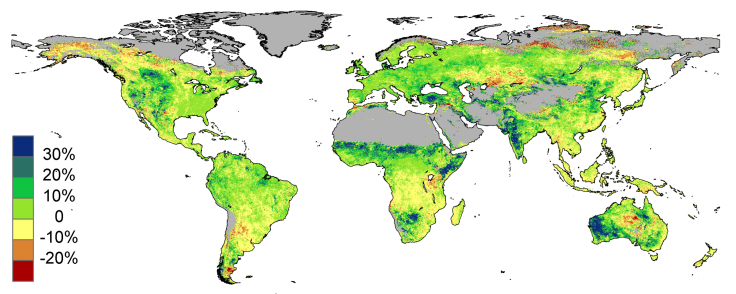Deserts Are ‘Greening’ From Carbon Dioxide Fertilization, Satellite Imagery Saw Arid Regions Bloom [PHOTO]

Carbon dioxide has turned arid deserts green, according to satellite observations released in a new study. In a process called “CO2 fertilization,” the gas boosted green foliage in the world’s driest regions.
Using satellites that detected leaf coverage and mathematical modeling, the study conducted by Australia’s Commonwealth Scientific and Industrial Research Organisation and Australian National University, found that in arid regions of Australia, North America, the Middle East and Africa, CO2 fertilization increased foliage by 11 percent over nearly three decades.
The process occurs when elevated CO2 levels enable a leaf during photosynthesis – where green plants convert sunlight to energy -- to extract more carbon from the air or lose less water to the air, or both, according to CSIRO. If each individual leaf uses less water, then the plant will respond by increasing its leaf production, said Randall Donohue, a research scientist.
"Our work was able to tease-out the CO2 fertilization effect by using mathematical modeling together with satellite data adjusted to take out the observed effects of other influences such as precipitation, air temperature, the amount of light, and land-use changes," Donohue said.
Researchers created a computer model of a given area and predicted carbon dioxide’s “fertilization effect” as increasing plant foliage by 5-10 percent over a 30-year period. Using satellite imagery, the team compared the model with real world changes that occurred between 1982 and 2010 and found that their predictions supported their theory that the gas helped plant growth, LiveScience reports.
Scientists have speculated CO2 fertilization was taking place, but it has been difficult to prove, Donahue said. While boosting foliage in dry areas can help forestry and agriculture, it can also hurt water availability, the carbon cycle, fire regimes and biodiversity, he added.
"Trees are reinvading grasslands, and this could quite possibly be related to the carbon dioxide effect," Donohue told LiveScience. "Long-lived woody plants are deep rooted and are likely to benefit more than grasses from an increase in carbon dioxide."
But a boost in greenhouse gases such as carbon dioxide could also be a cause for concern. For instance, changing rainfall patterns could diminish the positive effects of higher CO2 levels, LiveScience reports.
"Ongoing research is required if we are to fully comprehend the potential extent and severity of such secondary effects," Donahue said.
© Copyright IBTimes 2024. All rights reserved.





















